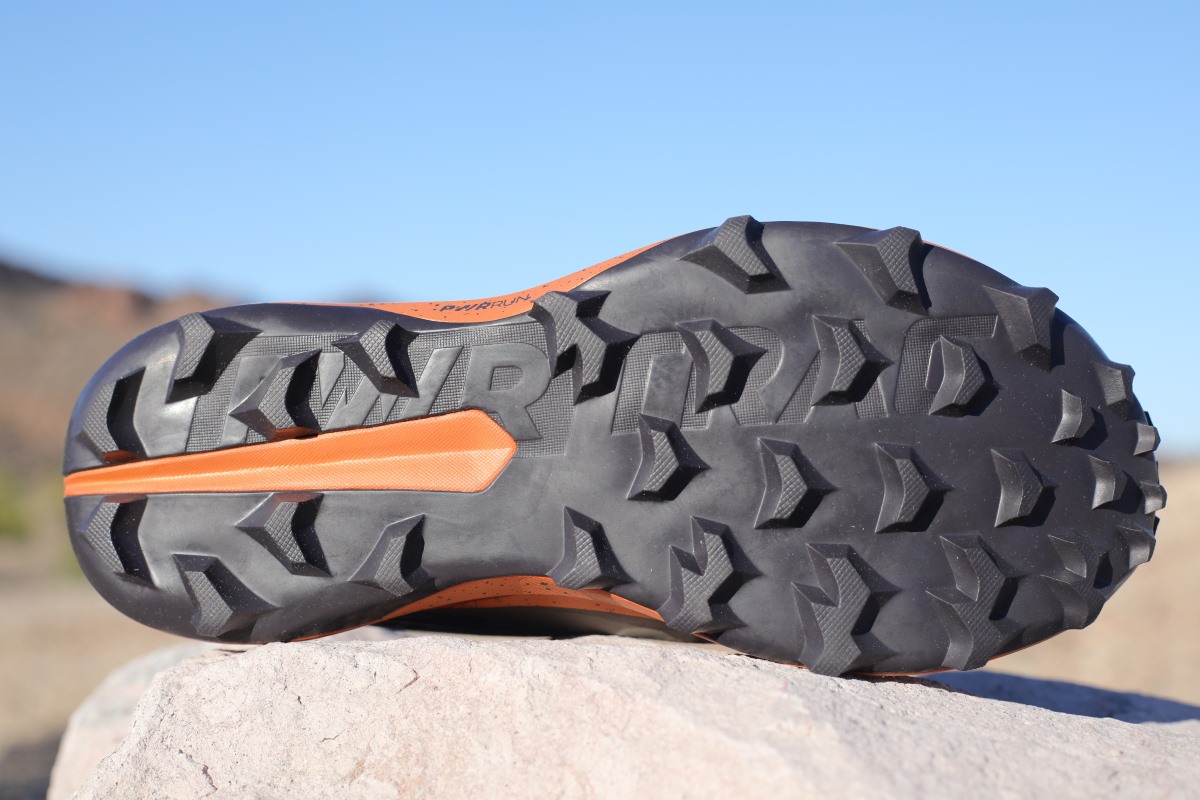For the latest on the Saucony Peregrine, check out our Saucony Peregrine 15 review.
Our Favorite Trail Running Shoes
Check out our Best Trail Running Shoes article to learn about our current favorite trail running shoes!
Saucony Peregrine 13 ST Review
The Saucony Peregrine 13 ST ($150) is the soft terrain version of the Saucony Peregrine 13 — see our Saucony Peregrine 13 review to learn more about this shoe.
This means that the Saucony Peregrine 13 ST incorporates beefier lugs and enhanced debris protection while maintaining the lightweight, nimble feel of the regular Peregrine 13, which is a widely popular trail running shoe that checks a lot of boxes when it comes to value, comfort, versatility, and performance. This shoe is specifically designed for mud, soft dirt and scree, and even slushy snow, and for the past couple years, this shoe has remained our favorite all-terrain mud shoe in our Best Trail Running Shoes for Mud guide.
With an actual weight of 9.95 ounces (282 grams) for a U.S. men’s size 9, the Saucony Peregrine 13 ST has a claimed stack height of 30 millimeters under the heel and 26 millimeters in the forefoot, a 4-millimeter drop, and 6.5-millimeter lugs.
We have found that this shoe is ideal for running on a variety of trail surfaces for distances up to 50 kilometers. During summer months, this shoe has become my go-to for staying upright while moving fast over steep, loose scree on the U.S. Pacific Northwest volcanoes. However, it also thrives on muddy trails during shoulder season, in ankle-deep moon dust during the driest part of the year, and in soft, slushy snow during the late winter thaw.
The only exceptions to this shoe’s all-terrain performance are hard-packed dirt, pavement, or smooth granite — in other words, surfaces that aren’t soft — where the shoe’s aggressive lugs don’t add much grip and also sacrifice some comfort.
We tested the Saucony Peregrine 13 ST and its predecessor, the Saucony Peregrine 12 ST — see our Saucony Peregrine 12 ST review — over the past couple years and have put hundreds of miles on both versions over every type of soft running terrain. Read on for more details on this shoe.
Shop the Women's Saucony Peregrine 13 STShop the Men's Saucony Peregrine 13 ST
Saucony Peregrine 13 ST Upper
While the Saucony Peregrine 13 ST midsole closely mimics the regular Peregrine 13, which we’ll talk more about below, each shoe’s upper differs in a few key ways. For one, this version has a protective film that helps it resist abrasion. Looking at the Peregrine 13 and Peregrine 13 ST side by side, you can see that this version has more TPU material along the base of the upper, which helps that abrasion resistance. Also, the mesh upper appears to be more tightly woven on this edition, which can also help keep mud and dust from getting inside the shoe and wearing holes in high friction areas.
Next, there’s a stretchy gaiter around the top to help keep mud and debris from getting in at the ankle. Although this sock-like gaiter is too shallow to fully keep pebbles and dust out if you’re running in ankle-deep scree or mud, it does help keep splatters from landing inside your shoes if you’re simply splashing along wet trails. The gaiter also helps with the shoe’s durability. As someone who tends to kick my ankles exactly where my shoe’s smooth mesh lining meets the upper material, I’ve noticed that this typical wear spot is holding up better in the Peregrine 13 ST because the shoe comes up a few millimeters higher on my ankle and the material is burlier.
Finally, the Peregrine 13 ST has a “speed lace” system, with thin, static laces that won’t soak up water and mud and then come loose or untied. Instead, these cord-like laces can be cinched from the top, and then the extra material and the toggle can be stowed inside a mesh pocket. This design helps the shoes maintain a secure fit even when they get wet or mud-soaked.
Notably, although the Peregrine 13 ST has a few extra design features to help it perform in wet conditions, it’s not a waterproof shoe. Saucony does offer a version of the regular Peregrine in a waterproof design, called the Saucony Peregrine 13 GTX. This shoe looks very similar to the Peregrine 13 — as opposed to the Peregrine 13 ST — with the key difference being the addition of a Gore-Tex waterproof membrane.
Saucony Peregrine 13 ST Midsole
The Saucony Peregrine 13 ST midsole is moderately cushioned, with a claimed 30 millimeters of stack height under the heel and 26 millimeters under the forefoot, leaving a 4-millimeter heel-to-toe drop. Compared to this shoe’s predecessor, the Saucony Peregrine 12 ST, the newest iteration has a slightly more cushioned feel, yet it’s even lighter weight and just as responsive.
When I updated my Peregrine 12 ST to the newer Peregrine 13 ST, I immediately noticed the added cushioning. Although it’s a subtle change, the effect was that the new version feels more substantial, especially around the heel and midfoot. At the same time, it does not feel clunky or heavy at all. As a result, I’d be willing to take this shoe for longer runs, up to 25 to 30 miles at a time.
The midsole foam itself is unchanged — it’s the same PWRRUN foam found in both the former Peregrine 12 and the current Peregrine 13. Our testers appreciate this foam’s balance of lightweight comfort and response. This shoe also contains a rock plate in the midsole. The rock plate helps to add some firmness to the underfoot cushion, and it protects the bottom of the foot from bruising while running on very technical trails or bombing down a rocky slope.
The Peregrine’s last has a traditional shape that hugs the heel and midfoot while allowing enough room in the toebox to wiggle the toes. At the same time, it’s not the wide, rounded toebox that we see with brands like Altra and Topo, and it runs narrower than most Hoka styles. The benefit is that this shoe offers a secure fit to runners with narrow feet, and it offers more precision than you get with a wider toebox.
I have a standard-width foot, and I like a balance of precision while also having room for my toes to splay out — and this shoe fits my foot great. That said, it would not be my top recommendation for someone who has a wide forefoot.
Finally, while the Peregrine 13 ST is not available in a wide fit, it’s worth noting that the regular Peregrine 13 does have a wide option.
Saucony Peregrine 13 ST Outsole
The Saucony Peregrine 13 ST is built with Saucony’s PWRTRAC rubber compound, which is the same material found in the current Saucony Peregrine 13, as well as the previous version of both the Peregrine and Peregrine ST.
Comparing the Peregrine 13 and Peregrine 13 ST side by side, the lug design and pattern looks very similar. The key differences are that the Peregrine 13 ST has slightly fewer lugs, its lugs are deeper — 6.5 millimeters versus 5 millimeters — and the outsole material appears a bit shiny.
While iRunFar’s testers agreed that the Peregrine 13 grips well on slick surfaces and sheds mud just fine, the Peregrine 13 ST performs even better when its deeper lugs bite into soft mud. Additionally, the smooth surface in between its widely spaced lugs allows mud to slide off the outsole rather than clump between the lugs and stick to the base of the shoe.
As a result, while the Peregrine 13 is a great all-rounder, the Peregrine 13 ST is among the best tools for the job when running surfaces are soft and sloppy.
Saucony Peregrine 13 ST Overall Impressions
The Saucony Peregrine 13 ST is a favorite among the iRunFar team when the trails get muddy and slick. Our U.S. Pacific Northwest runners also love this shoe for running up and down volcanoes, which is like running on kitty litter. This model’s deep, widely spaced 6.5-millimeter lugs excel at gripping soft surfaces and shedding mud.
However, since this is a specialized shoe for soft or muddy conditions, I don’t use it as a daily driver. This means I’ve gradually put miles on it over the course of six or seven months, and it’s not getting the same kind of wear as my day-in and day-out running shoes.
Nevertheless, this shoe has endured a disproportionate number of miles on volcanic rock, which acts like a cheese grater with typical running shoes. For example, I wore a pair of Hoka Tecton X 2 running shoes on a long run volcano adventure last July and the granular debris partially disintegrated the soft interior lining of those shoes — yikes! By comparison, the Peregrine 13 ST shoe is holding up very well so far.
That said, the tradeoff with a specialty shoe like the Peregrine 13 ST is that its lugs feel more like cleats when running on pavement or hard-packed trails, and they wouldn’t be ideal on wet, slippery granite or icy surfaces. As a result, while this shoe thrives on almost all types of terrain, I wouldn’t recommend it as your one-and-only trail running shoe.
The Saucony Peregrine 13 ST has remained our favorite all-terrain mud shoe in our Best Trail Running Shoes for Mud guide. However, if you only run on soft trails and mud occasionally, you’ll probably be happier with the Saucony Peregrine 13 — a well-rounded shoe with moderate, 5-millimeter lugs — which is one of our top picks in our Best Trail Running Shoes guide.
Shop the Women's Saucony Peregrine 13 STShop the Men's Saucony Peregrine 13 ST
Call for Comments
- Do you wear a mud-specific trail running shoe? Which shoe?
- Have you tried the Saucony Peregrine or Saucony Peregrine ST? What did you think?
[Editor’s Note: If you’re affiliated (i.e., an employee, ambassador, etc.) with a brand, please share your relation in each of your comments on this article. Thanks!]
Our Favorite Trail Running Shoes
Check out our Best Trail Running Shoes article to learn about our current favorite trail running shoes!





